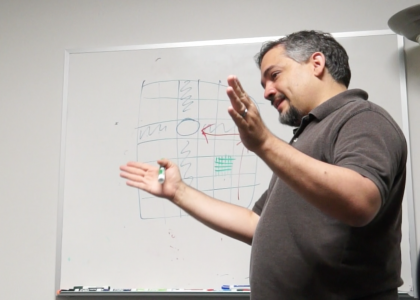The Study of Evolution in Artificial Organisms

Dr. Ofria’s research group explores Computer Science and Evolutionary Biology to help understand fundamental concepts in each field. His group writes self-replicating computer programs and puts them into a computational environment that subjects the programs to mutations and natural selection. The digital organisms then evolve in different and exciting ways, providing a testing environment for understanding the basic principles of Evolutionary Biology. Results from this research can be applied to computational and engineering problems.
Dr. Ofria is interested in understanding biological complexity, asking questions such as: How do organisms learn to navigate, and how they acquire first simple, and then complex, tasks? For example, one member of Dr. Ofria’s group is studying how a program which begins with only the ability to copy itself, can eventually develop a memory to aid in tasks like navigation. These navigation programs evolve in a virtual environment and have been successfully downloaded into mobile robots that are able to follow a light gradient (similar to E. Coli following glucose gradient in a petri dish).
It is common to find examples of how an organism can make small improvements that result from a series of incremental changes. However, it is difficult to find examples of how evolution can make what appear to be large, one-time jumps. Organisms are often described as having irrevocably complex structures that could not have occurred using small incremental steps. However, Ofria’s group has shown that organisms can re-purpose code originally designed for completely different tasks and that they can make these one-time jumps predictably in his artificial environment.
Dr. Ofria’s group has always used High Performance Computing in their research and, previous to the existence of the HPCC, built their own systems. However, since the inception of the HPCC, their group has been able to use both more and faster processors for their research, which has encouraged more parallelization in their research.
Dr. Ofria’s group presently consists of about 20 graduate students and postdocs, all of whom work at some level with the High Performance Computing Center.
Dr. Ofria and his colleagues recently have received a prestigious NSF Science and Technology Center grant. Their center, called BEACON, combines researchers from five different universities to study Computer Science, Evolutionary Biology and Engineering and find evolutionary solutions for solving research and real-world problems.
